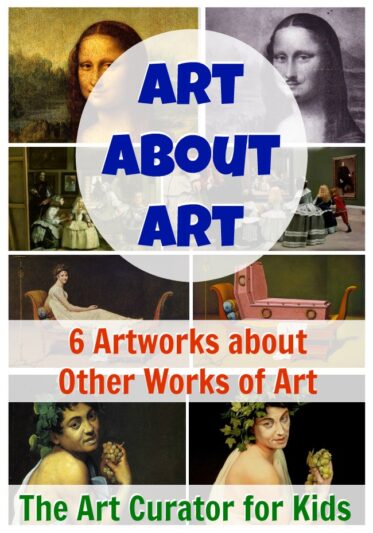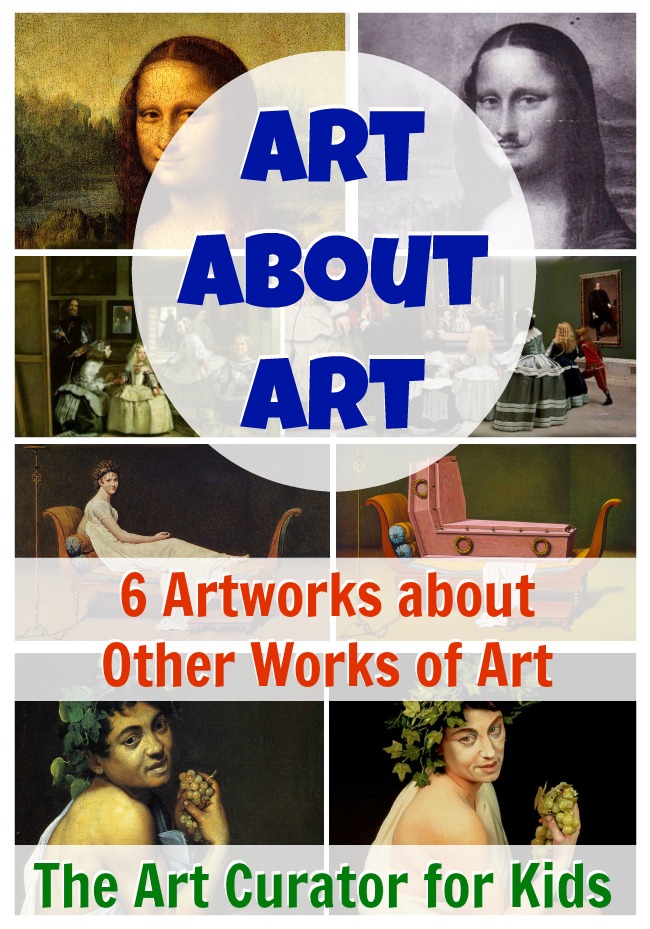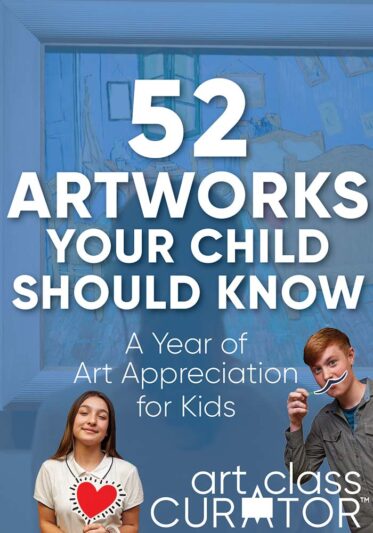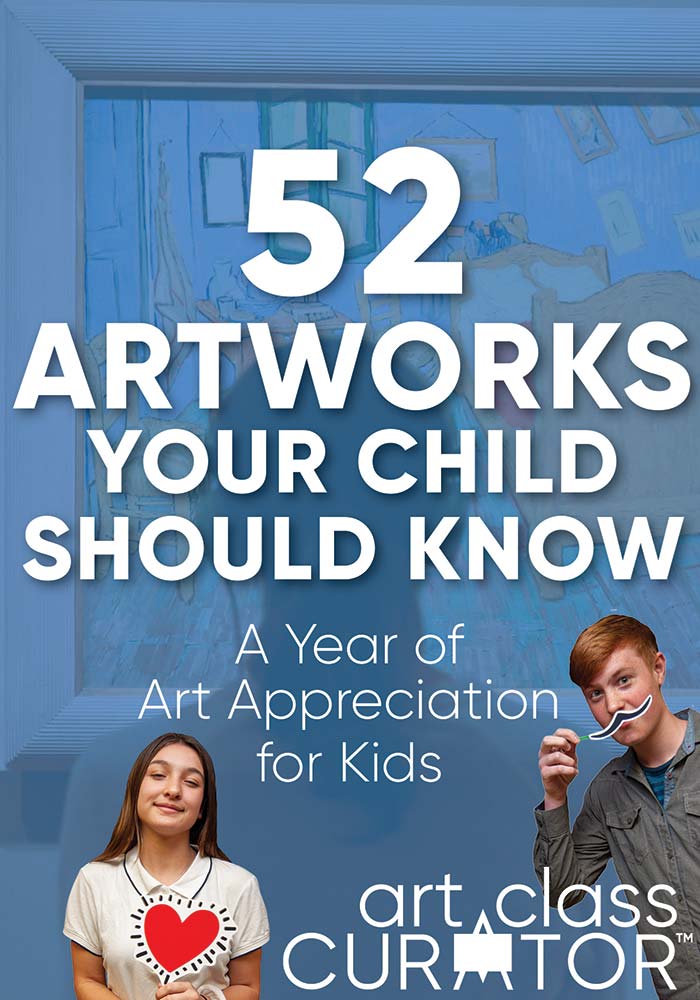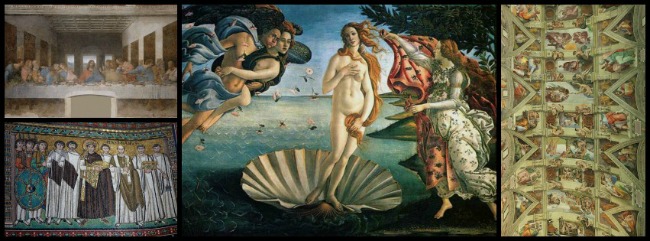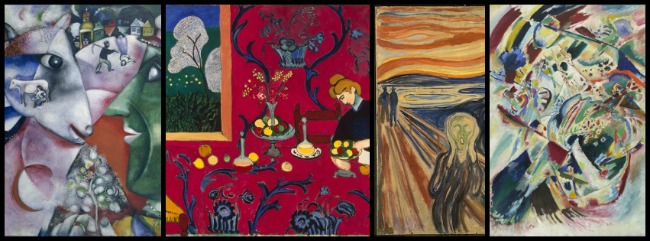I’m a big art history nerd, so I love art that references other artworks in funny and interesting ways. Check out these 6 works of art that are about other works of art. These works add something new to the conversation and make us think about the original works of art differently. These works would be a really fun addition to your art and aesthetics lessons with your high school or college art or art history classes.
For more information about how to talk about art with kids, check out this post on how to look at art with kids for tips on discussion artworks. You can also use my art worksheets with these artworks.
Yasumasa Morimura, Las Meninas Reborn in the Night: Las Meninas renacen de noche IV: Peering at the secret scene behind the artist, 2013
It was close to impossible to pick just one artwork by Yasumasa Morimura! He has done dozens or more of artworks where he adds himself into artworks by Rembrandt, Frida Kahlo, Leonardo da Vinci, Vincent van Gogh, Vermeer, Salvador Dalí, Andy Warhol, and many more! Visit this website to see them all.
I chose this one because it shows another view of the artwork and makes us think about it in different ways. We see what the artist is painting (with the artist’s face on the girl on the painting), and we also see the painting in situ at the Prado Museum in Madrid.
He did other versions of this painting as well. He recreated it with himself as all of the characters and did one with the King and the Queen looking at the painting.
I have seen Yasumasa Morimura be referred to as the Cindy Sherman of Japan. One of Cindy Sherman’s works is down below.
Rene Magritte, Perspective: Madame Récamier by David, 1951
This painting by René Magritte always makes me chuckle. Magritte has a masterful way of making ordinary things amusing. I’m not going to say much about this one, because I’d like you and your students to ponder it on your own.
Cindy Sherman, Untitled (#224), 1990
Contemporary artist, Cindy Sherman, created a series of historical portraits where she put herself into famous portraits. Young Sick Bacchus by Caravaggio is said to be a self-portrait of the artist as the Roman god of wine, the harvest, theatre, and “ritual madness.”
You can read an interview with Cindy Sherman about the history portrait series on the art:21 website.

Aesthetics Lesson Bundle
What is art? Get your students in the mindset to THINK in art class and lead fun art discussions with this lesson bundle!
Robert Rauschenberg, Erased de Kooning Drawing, 1953
This artwork is the focus of another one of the Puzzles about Art aesthetics lessons I have written about on the website in the past.
Here’s the text from the activity sheet I used in my college classes about this art. The below text is from Battin, M.P., Fisher, J., Moore, R., and Silvers, A. (1989). Puzzles about art: An aesthetics casebook. New York: St. Martin’s Press.
In 1953, Robert Rauschenberg, a young though not inconsequential artist, asked Willem de Kooning (famous artist) to participate in an art project. De Kooning, who was not only older and much more established than Rauschenberg, but whose works sold for considerable sums of money, agreed to participate and gave Rauschenberg what he considered to be an important drawing which was executed in heavy crayon, grease pencil, ink, and graphite. Rauschenberg spent a month on the work, erasing it completely. Then he placed the de Kooning drawing in a gold leaf frame and hand-lettered the date and title on the drawing: Erased de Kooning Drawing, 1953. Rauschenberg had not only erased de Kooning’s work, but he had also exhibited the “erasure” as his work of art.Has Rauschenberg created a work of art, destroyed one, or perhaps both? Why?“
The de Kooning work from the picture is NOT the one he erased. I included it as an example of a de Kooning drawing so you could have an idea of what it looked it before Rauschenberg erased it.
Guerilla Girls, Do Women Have to Be Naked to Get Into the Met Museum?, 1989–2005
This iconic Guerilla Girls work is not necessarily about Ingres’ painting, but I have included it to show where they got the image from the poster. The Guerilla Girls are an anonymous group of women dedicated to fighting sexism in the art world. They point out injustices and inequalities at museums and galleries with public art pieces, billboards, t-shirts, bumper stickers, handbills, etc. Their protest art is data-driven and often uses humor to make their point.
Marcel Duchamp, L.H.O.O.Q., 1919
Marcel Duchamp and the dada art movement questioned the idea of art. What is art? Can you take the most famous painting, make a print of it, add a mustache and a caption, and it still be a work of art? Is art about the idea or the image?
The letters are wordplay. If you say those letters in french quickly, it sounds like you are saying the equivalent of “there is fire down below.”
Thanks for visiting! Which of these do you find the most interesting? What artworks did I miss? Share your thoughts in the comments!
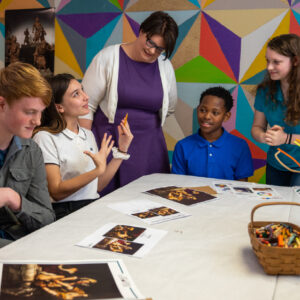
Get the Full Lesson!
This Lesson is in The Curated Connections Library!
Find the full lesson from this post along with hundreds of other art teaching resources and trainings in the Curated Connections Library. Click here for more information about how to join or enter your email below for a free SPARKworks lesson from the membership!

